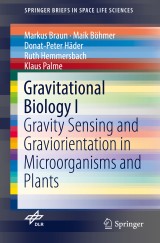Details

Gravitational Biology I
Gravity Sensing and Graviorientation in Microorganisms and PlantsSpringerBriefs in Space Life Sciences
|
58,84 € |
|
| Verlag: | Springer |
| Format: | |
| Veröffentl.: | 20.07.2018 |
| ISBN/EAN: | 9783319938943 |
| Sprache: | englisch |
Dieses eBook enthält ein Wasserzeichen.
Beschreibungen
This book summarizes what is currently known about gravity sensing and response mechanisms in microorganisms, fungi, lower and higher plants; starting from the historical eye-opening experiments from the 19<sup>th</sup> century up to today’s extremely rapid advancing cellular, molecular and biotechnological research. All forms of life are constantly exposed to gravity and it can be assumed that almost all organisms have developed sensors and respond in one way or the other to the unidirectional acceleration force,this books shows us some of these different ways.<div><br></div><div>The book is written for plant biologists and microbiologists as well as scientists interested in space and gravitational biology.</div>
<p>Chapter 1: Gravity Sensing, Graviorientation and Microgravity.- Chapter 2: Methods for Gravitational Biology Research.- Chapter 3: Gravitaxis in Flagellates and Ciliates.- Chapter 4: Gravitropism in Tip-Growing Rhizoids and Protonemata of Characean Algae.- Chapter 5: Gravitropism in Fungi, Mosses and Ferns.- Chapter 6: Gravitropism in Higher Plants: Cellular Aspects.- Chapter 7: Gravitropism in Higher Plants: Molecular Aspects.- Chapter 8: Bioregenerative Life Support Systems in Space Research.</p><p><br></p>
<p><b>Dr. rer. nat. habil. Markus Braun</b> is Head of the Space Life Sciences Program, Space Administration, German Aerospace Center DLR and serves as German delegate of the Human Spaceflight, Microgravity and Exploration Program Board of the European Space Agency ESA. He is appointed faculty member at the University Bonn and coordinator of the Gravitational Biology Group. Special focus of his research is on gravitational biology, plant gravity sensing mechanisms and bioregenerative life support. He was principle investigator of gravitational biology projects conducted on microgravity simulators, sounding rockets, parabolic flights, Space Shuttles, biosatellites and on the International Space Station. </p> <p> </p> <p><b>Dr. rer. nat. Maik Böhmer </b>is a lecturer and group leader at the Institute for Plant Biology and Biotechnology at the Westfälische Wilhelms-Universität (WWU) Münster. He has received his PhD from the Max-Planck Institute for Plant Breeding Research in Cologne and worked as a PhD fellow at the University of California San Diego. His research topic is plant adaptations to adverse environments, including drought, salinity, pathogens and microgravity. Since 2012 he is involved in gravitational biology research and has been a Principal Investigator (PI) in several micro-g related drop tower and parabolic flight campaigns.</p> <p><b>Prof. em. Dr. Dr. h.c. Donat-Peter Häder</b> is retired director of the Botanical Institute and Botanical Garden at the Friedrich-Alexander Universität Erlangen-Nürnberg and held the chair for Ecophysiology. His research focuses on the behavioral, physiological and molecular graviperception mechanisms in microorganisms using parabolic flights, sounding rockets, satellites and the International Space Station (ISS) as well as simulated microgravity. He has been principal investigator (PI) of several micro-g related studies on ground and in space. He is the author of close to 700 publications and has written, translated and edited 28 books.</p> <p><b>Dr. rer. nat. habil. Ruth Hemmersbach</b> is<b> </b>Head of Division Gravitational Biology and Deputy Director of the Institute of Aerospace Medicine of the German Aerospace Center DLR. Her research topics are related to questions in gravitational biology with a focus on gravisensory mechanisms in single cells. She and her team have developed devices for studies under altered gravity conditions (centrifuges for artificial gravity and microgravity simulators). She has been principle investigator of gravitational biology projects conducted on various platforms providing real microgravity conditions. </p> <p><b>Prof. Dr. rer. nat. Klaus Palme</b> is Head of the Department of Botany/Plant Molecular Physiology at the Albert-Ludwigs-Universität Freiburg, Member of the Board of Directors of the Center for Biosystems Analysis and Member of the Center of Biological Signalling Studies. His research on plant hormone signalling made globally acknowledged breakthroughs fuelling the analysis of this important plant process for many years and by numerous followers around the world. He opened new important fields in plant biology. Many of his more than 200 publications are highly cited. He participated in many Parabolic Flight campaigns and space missions (ISS, MASER, TEXUS). </p>
This book summarizes what is currently known about gravity sensing and response mechanisms in microorganisms, fungi, lower and higher plants; starting from the historical eye-opening experiments from the 19<sup>th</sup> century up to today’s extremely rapid advancing cellular, molecular and biotechnological research. All forms of life are constantly exposed to gravity and it can be assumed that almost all organisms have developed sensors and respond in one way or the other to the unidirectional acceleration force,this books shows us some of these different ways.<div><br></div><div>The book is written for plant biologists and microbiologists as well as scientists interested in space and gravitational biology.</div>
Depicts the different ways, various organism respond to gravity Cellular and Molecular aspects of gravitropism are described Deals with algae, fungi, higher and lower plants and microorganism Displays high-tech methods used in space and ground gravity research.
Depicts the different ways, various organism respond to gravity<p>Cellular and Molecular aspects of gravitropism are described</p> <p>Deals with algae, fungi, higher and lower plants and microorganism</p> Displays high-tech methods used in space and ground gravity research.
Diese Produkte könnten Sie auch interessieren:

Tropical and Parasitic Infections in the Intensive Care Unit

von: Charles Feldman, George A. Sarosi

149,79 €















